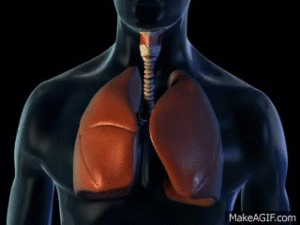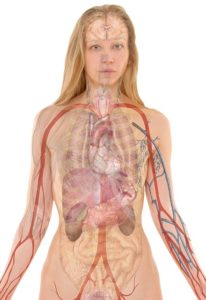Chronic hyperventilation

chronic hyperventilation
Chronic hyperventilation is a situation in which the respiratory center in the brain has become accustomed to a low level of acidity in the blood. Because the respiratory center regulates the respiratory rate on the basis of that acidity (see the extensive explanation about the functioning of the respiratory center), the respiratory frequency in people with chronic hyperventilation is too high. They breathe more than is actually necessary.
How does chronic hyperventilation develop?
In the section on acute hyperventilation it was already made clear that hyperventilation is a normal body function. So how is it possible that many people have a respiratory center that has become accustomed to low acidity? And that these people chronically hyperventilate because of this? This situation develops because the respiratory center is adaptive. This means that the respiratory center can re-adjust itself to a different acidity.
This can clearly be seen in for example pearl fishermen who – due to continuous swimming under water – can hold their breath much longer than the average person. Their respiratory center is accustomed to a higher acidity level than normal. Therefor the breathing impuls given by the respiratory center comes much later.
So the respiratory center can adjust itself to both a lower and a higher acidity level in the blood. In chronic hyperventilation the respiratory center has become accustomed to a low acidity level.
But what causes the respiratory center to re-adjust itself?
With prolonged stress or tension, there is a continuous increased adrenaline level in the blood. As a result, people are hyperventilating unnoticed. This is not a problem in the first few months. The CO2 buffers in the blood (HCO3 ions) compensate for this mild form of hyperventilation. But in the course of several months these buffers are gradually being used up. The acidity level in the blood decreases as a result. And the respiratory center is starting to get used to the lower acidity. If you would like to know more about the causes of this, please read our article on causes of hyperventilation.
What happens in the body?

If the acidity in the blood is too low, we call it an alkalosis. The blood then becomes alkaline (= opposite of acid). This condition causes 2 specific effects:
- Blood vessel narrowing. The blood vessels squeeze. That is because the acidity regulates the width of the blood vessels in the body. This may result in a decrease in blood supply in the brain and other organs of 30 to 40%. It leads to an oxygen deficiency in, for example, the brain. This then impacts the brain functions. Examples of this are blurred vision, hearing everything from a distance, concentration problems, not being able to think clearly and a feeling of threatening loss of consciousness.
- Reduced oxygen exchange. Because the environment of the cells becomes alkaline, the red blood cells can no longer properly deliver their oxygen to the cells and tissues of the body. The red blood cells need an acid environment for this. The result is an extreme fatigue feeling. The muscles then try to compensate for the loss of carbon dioxide. They do this by depositing lactic acid. And that in turn leads to muscle aches and cramps and trembling muscles. It is also often the cause of the known symptom ‘pain in the chest’ in hyperventilation.
The alkalized blood causes – because of these two reactions of the body – a large number of symptoms.
Curing chronic hyperventilation
Because the respiratory center is adaptive, it means there is an easy solution to the chronic hyperventilation problem: we must ‘persuade’ our respiratory center to accept a higher level of acidity in the blood. The Dutch neurologist Ph. D. B. Snitslaar lived in the Netherlands Antilles as a young man. He combined his experiences with swimming under water and his later studies on the respiratory center in the brain. He discovered the connection between the hypersensitive respiratory center for
carbon dioxide and chronic hyperventilation.
Ph. D. Snitslaar understood that it should be possible to cure the chronic hyperventilation syndrome in a relatively simple way. For more information about curing chronic hyperventilation syndrome, see the articles on curing chronic hyperventilation and the HyperVen therapy.

 acute hyperventilation
acute hyperventilation hyperventilation attack
hyperventilation attack